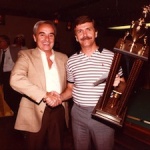The Big Time
It’s been 10 years since the International Pool Tour died. How will history judge the short-lived $13 million venture that showed the promise and peril of attempting to bring pool into the big time?
By Nick Leider
It almost seems like a fever dream, now that it’s been a decade since its death. The International Pool Tour, founded and funded by infomercial maven Kevin Trudeau, held four events in 14 months that awarded more than $6 million in prizes. Pool had not seen — and most likely will not see — anything like this in the history of the sport.
Efren Reyes, winner of two tournaments, pocketed $765,000. The matches were live broadcast across Europe in primetime. Players were told of guaranteed income in the six figures.
But now, 10 years after the IPT’s final event, the World Open, left players with little more than IOUs for $3 million, Billiards Digest revisits the IPT’s unbelievable rise and equally astonishing fall. While setting the record straight on what remains one of the most controversial eras in modern pool, one question begs for an answer:
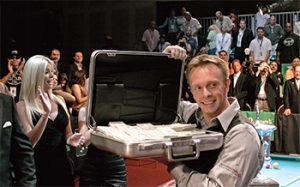
Though short-lived, the IPT still showered pros like Thorsten Hohmann with briefcases full of cash.
What was the IPT’s lasting effect on the game we love?
The Facts
Before telling the story of the IPT, it’s imperative to present the facts that are often lost in the legend of the IPT.
First, every player who won money received what they were due. The $3 million in prizes from the World Open, the abbreviated tour’s last stop, were awarded, though it took 14 months and a series of installments to meet the tour’s obligations.
Second, players did lose $2,000 paid to play in qualifying events for a tournament that never happened. The IPT postponed and then cancelled its future events, leaving those who had ponied up that qualifier money without recourse.
“Some players received that money back and others did not,” said Deno Andrews, the IPT tour director who handled day-to-day operations. “I can’t remember how many ended up losing that money. It was not that many players — with that said, any [number] more than zero was too large.”
Finally, among the top players who competed on IPT, the consensus was that, despite the missteps, broken promises and eventual failure, it was a good thing while it lasted.
“My brothers on tour, we were all really happy about Trudeau and the IPT,” said Rodney Morris, who earned $150,000 with a runner-up finish at that maligned World Open. “We made some money and we had a great time. We were more than happy to be a part of it. We wished things would’ve worked out, but I have nothing against anyone.”
Thorsten Hohmann, who netted $350,000 by winning the North American Open, agrees.
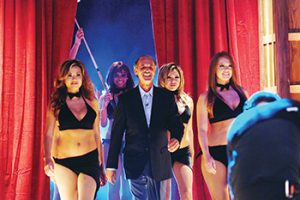
Trudeau’s events were lavish affairs, brimming with pomp and circumstance, as showcased in the Battle of the Sexes match between Loree Jon Hasson and Mike Sigel.
Still, the IPT, coming on so strong and crashing so quickly, affected much more than players’ bank accounts. To see these impacts, it’s worth starting at the beginning.
The First Time
The World Championship Open (Aug. 20, 2005)
Trudeau’s entry into professional sports was a moment of serendipity for pool, a bit of luck for a sport that desperately needed it. The women’s game, buoyed largely by the WPBA Classic Tour, was in decent shape, with events regularly appearing on ESPN and top players able to support themselves with tournament winnings. The men’s side, though, had little as far as organization. The Professional Billiards Tour Association had collapsed in the decade prior. Outside of a few big world championship tilts and the annual U.S. Open 9-Ball Championship, organization was minimal and cooperation was almost nonexistent.
The seeds of the IPT, though, were planted a decade earlier in 1994. Trudeau was already a successful businessman, but he was not yet riding what would be a wave of commercial success based largely on his “Natural Cures” brand, including a New York Times bestselling book and ubiquitous late-night infomercials. Long a fan of pool, he caught a radio advertisement for an exhibition in the Chicago area featuring Hall of Famer Mike Sigel.
“Kevin got in touch with me saying he wanted personal lessons,” Sigel said. “We became friends and I would see him every few weeks. And then I got it in my mind. I said, ‘Hey, you got all this money and you love pool. Let’s do something for the game.’
“I nagged him for 10 years, saying we should do something together. Finally, one day when we were playing pool, he said, ‘Let’s do it.’”
The two scribbled down some notes about prize money. Sigel imagined top prizes around $100,000, with other top finishers pocketing proportionally big bucks. Trudeau, though, had bigger ideas from the start.
“He looked at all that, without even adding it up,” Sigel said, “and he said it’s got to be bigger. For him, from the start, it wasn’t a matter of doing something. It was a matter of how big it was going to be.”
Eventually, the plan was to hold a kickoff challenge match in August 2005 between Sigel and fellow Hall of Famer Loree Jon Jones in Las Vegas. Dubbed the World 8-Ball Championship, the battle of the sexes paid the winner $150,000 with a consolation prize of $75,000. Trudeau threw a lavish party the night before the event, replete with celebrities. On the day of the Sigel-Jones match, the celebrities (actors Paul Sorvino, Allison Janney and Anthony Anderson, rapper DMX and boxing legend Thomas Hearns among them) entered the arena in true red carpet style.
Deno Andrews was taken with Trudeau’s insistence on this being like nothing pool had seen before.
“Everything had to be big. We did nothing half-assed,” Andrews said. “What gets him going is entirely different than what gets the rest of us out of bed. He wanted it big and he wanted it immediately.”
By August, the IPT had crash-landed on the pool world.
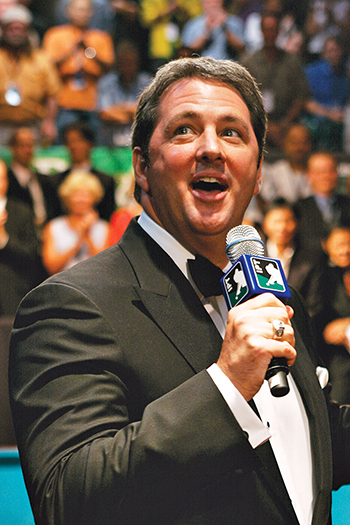
With media maven Trudeau at the helm, “everything had to be big.”
If a guy wanted to get pool players’ attention, big money and bright lights aren’t the worst ways to do so.
The Best of Times
The King of the Hill 8-Ball Shootout (Nov. 30-Dec.4, 2005)
The North American 8-Ball Championship (July 22-30, 2006)
The IPT initially started with 150 players hand selected by Trudeau and the IPT brass. Potential tour members had to apply for a spot on this lucky list, which may be the first and only time pool players put together resumes en masse.
A group of players automatically qualified based on past performance. Think Johnny Archer, Efren Reyes, Rodney Morris and other world-class talents. A dozen living Billiard Congress of America Hall of Famers received automatic entry and a $30,000 bonus simply for being part of the tour. Other players had to apply to tour membership. Darren Appleton, then a professional English 8-ball player but largely unknown in the U.S., emailed his application to the tour hoping that his unmatched record in a slightly different discipline would earn him a spot. (It did.)
The King of the Hill event, however, would only see 42 players compete for the $1 million prize fund, with $200,000 going to the winner. Still, the IPT managed to get all 150 players to Orlando for the event, because a mandatory players meeting promised to detail just what the tour had in store for its first year.
“It was the greatest speech I’ve ever heard,” said Thorsten Hohmann, of Trudeau’s pitch to the players. “It was incredible. I wasn’t really too aware of everything until I got to Orlando and heard Kevin. That made me realize: Holy shit. This is something big.”
Appleton, whose involvement with the tour led to him ditching English 8-ball for the American variety, was equally blown away.
“That players meeting, [there] was amazing excitement. I felt like a professional sportsman,” he said. “This was the biggest thing to happen for pool.”
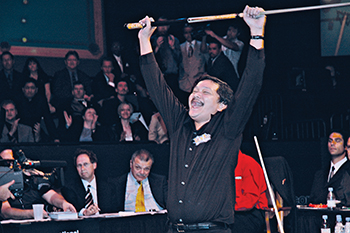
Reyes scored pool’s biggest ever prize.
Six months later, the North American Open brought 200 players to the Venetian in Las Vegas for a chance at the $2 million purse. The top prize was $350,000, the biggest single payday in the history of pool. EuroSport was broadcasting the event live in primetime. Deals were made with Outdoor Living Network to replay the matches for North American audiences. Before a ball was struck, this event was the most significant tournament in years.
The grueling round-robin, multi-round format had players playing four or five race-to-8 sets a day, often clocking more than 12 hours at the table. Hohmann eventually prevailed over Filipino snooker convert Marlon Manalo. But what happened on the table took a backseat to the event itself. The bright lights, the professional production, the class of such an event seemed to mark pool’s arrival as a legitimate sport.
But just two months later, at the IPT’s fourth event, the wheels fell off what everyone thought was pool’s gravy train.
The Worst of Times
The World 8-Ball Championship (Sept. 3-9, 2006)
The World 8-Ball Championship began with Trudeau announcing the cancellation of a scheduled event in London, which had some of the 200 players nervous about what was to come. Regardless, the $3 million prize fund went a long way to relieving any anxiety among the players.
The grueling tournament schedule, again having players compete nearly nonstop for days at a time, left Rodney Morris facing Efren Reyes for the $500,000 top prize. The on-table action ended with the Filipino legend pocketing the top prize while Morris “settled” for $150,000.
Or so it seemed.
All the players left the Grand Sierra Resort and Casino in Reno, Nev., with nothing. Players walked away with promises of future payments, but concerns that were raised at the players meeting became very real for those with a stake in the game.
“That Sunday, Kevin came to me and said the money wasn’t in the bank,” Andrews said. “I’ll never defend him not paying the players. That was wrong and it will go down in history as wrong. But I told him, 100 percent, he needs to pay the players and he said he would.”
Rumors circulated about a proposed deal with Stanley Ho, a billionaire casino magnate based in Hong Kong, to buy the tour. The supposed windfall from this would have supported the tour’s future, Trudeau insisted. But an agreement never materialized. Also, on Oct. 13, 2006, President George W. Bush signed into law the Unlawful Internet Gambling Enforcement Act, which outlawed wagering over the Internet for individuals in the U.S. This, according to the IPT, impacted the tour’s ability to market itself to potential buyers.
Over the course of 14 months, in nine installments of 11 percent, the payments arrived. All the while, no further tournaments were scheduled. The IPT staff, once more than 20 people, was slashed to a skeleton crew of five. Unable to produce profits through events, Andrews pivoted to reducing costs and raising what revenue he could through streaming recorded matches online, selling DVDs and collecting TV and product royalties.
The money wasn’t flooding in, but it was substantial enough to cover roughly half the amount owed to players, according to Andrews, with Trudeau covering the remainder.
“He could’ve filed for bankruptcy,” Andrews said. “He could’ve stiffed the players, but two months after that tournament, I did everything I could to persuade him to commit to paying the players.”
While the payments trickled out, the IPT held seven challenge matches, one-on-one events that were streamed online. The response was tepid and a steep decline from the glitz and glamor of the major tournaments that preceded them. The tour continued on in a sense, but it was evident to everyone within the sport that the IPT of 2007 was a far cry from what the tour had been just months before.
With the future of the IPT falling well short of expectations, Sigel took issue with players who quickly lost faith in the IPT.
“When players started knocking [Trudeau], I couldn’t believe it. That has to leave a bad taste in your mouth,” he said. “That’s when I thought, if it was me, I wouldn’t pay them and just go bankrupt. But he paid him. That’s the kind of guy he was.”
Andrews, however, puts blame on those around the game.
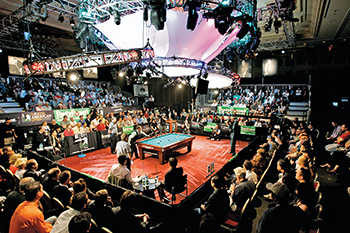
No expense was spared in the production of IPT events, including a sparkling arena to dazzle the masses.
Regardless of where blame lies, those who had the most to gain from the IPT adventure felt a real sense of loss once it was clear things weren’t going to turn out as advertised.
“I had a chance to win $500,000 and then I had to go try to win $10,000?” Morris said. “I lost a lot of motivation. I did a lot of soul searching at that time. For about a year there, I didn’t know what I was going to do. I was depressed for a while.
“It was real hard. I didn’t want to play at all. For a year, I was in a coma. I could’ve been on the “Walking Dead” — just walking around without an idea.”
Hohmann, another player who had profited immensely from the IPT’s short run, expressed similar feelings.
“It wasn’t like the tour ended at once,” he said. “It was a bit of a slow death — them dragging it out with exhibition matches. Of course I fell into a slump … It took me a few years to recover from that. You have these high expectations and then you’re back to playing in tournaments where you’re walking away with $2,000. It was hard.”
The End of Times
Once the players had been paid in full, Andrews met with Trudeau to discuss the IPT. More than $13 million had been invested, including prize money, production costs and marketing. The operation, already stripped to its bare minimum, was barely paying for itself.
The IPT, as it had been packaged from the beginning, was all but dead and buried. At that point, pool’s golden goose decided to pull the plug.
The slow death, as Hohmann put it, had come. But now, in 2016 and a decade after the cash was stacked on the pool table at the first event, the question still remains: Was the IPT a net positive or negative for pool?
“It was good,” Sigel said. “To this day, I defend the IPT whenever I hear someone talk about it. Add up all the money in the years before and after and it won’t come close to the $13 million Kevin put into the game.”
Sigel, who first hatched the concept of the IPT, agrees with Andrews, who was involved in the execution of that idea.
“Ultimately, it was good,” Andrews said. “If you remember what it was like before the IPT, it was very similar to what it is now. It was exactly like it is today … We created an entirely alternate universe for pool. It happened in a vacuum and ultimately I don’t think it had much of an effect on pool. It didn’t impact the actual state of the sport today.”
“He invested an amazing amount of money and it was great,” Appleton said. “I started playing American pool because of the IPT. I have that time to thank for my career and everything I’ve achieved since then.”
“Pool players can be some of the most loyal, trusting and straightforward people,” Andrews said, who continued to work with Trudeau until 2013. “Really the promoters are goofier than the players. The players show up, they pay their expenses, they pay the entry fees, they practice. They do all this stuff, and it’s such a basic thing: Pay them on time.
“I still hear about this. The money isn’t there or the added money was different than what was published … We were as guilty as anybody, but the players were overwhelmingly supportive.”
IPT Round Three: The Plot Thickens as the Field Thins
Round three starts today in the International Pool Tour’s North American Open and already 17,066 games have been played. Fatigue certainly played a role yesterday with 120 players facing a $5,000 difference in payout as they were whittled down to 60 in 12 straight hours of 8-ball action. The 60 remaining contenders who advanced to round three have been placed into 12 groups of five players each. Three players from each group will advance to the next round. The 24 who are eliminated will receive a lovely parting gift of $10,000.
Here’s a breakdown of yesterday’s highlights:
Mike Sigel was eliminated with a 2-3 record after losses to Marlon Manalo, Marko Lohtander and Quinten Hann. “The Mouth” settled for 61st and a $5,000 consolation prize.
The female players are near extinction, survived only by Sarah Ellerby who edged out Corey Harper by less than one percentage point in win average to advance to round three. Both Loree Jon Jones and Allison Fisher went winless in round two, and Gerda Hofstatter was eliminated with only one win.
Only eight players went undefeated throughout yesterday’s round, including three Americans: David Matlock, Nick Varner, and Charlie Williams. Also unscathed: Australian Quinten Hann, Filipino Santos Sambajon, Mexican Rafael Martinez, Mika Immonen of Finland, and Ivica Putnik of Croatia.
The Filipino contingent is now down three men, with Warren Kiamco and Gandy Valle eliminated after round two, and Jose Parica eliminated after round one. Still, 10 of the original 13 remain and most dominated their groups. Francisco Bustamante fell to Efren Reyes, but has the highest winning percentage of the entire field at 73.68 percent. (Johnny Archer is second with 70 percent.)
Snooker superstar Ronnie O’Sullivan held on by the skin of his teeth, with only two wins, but advanced on the merit of his winning percentage. On the other hand, Takeshi Okumura missed out on advancing by 0.03 percent to Larry Nevel.
Veterans Allen Hopkins, Kim Davenport, Keith McCready are all heading home. George San Souci and Tony Chohan went winless in round two. Other notables who are heading home with $5,000 consolation prizes: Danny Basavich, Jeremy Jones, George Breedlove and Oliver Ortmann.
Round three is upon us, and each player will play five matches among formidable fields. Here’s a quick analysis:
Ellerby will have to face two top Americans: Gabe Owen and Charlie Williams and two Filipinos: Marlon Manolo and Ronato Alcano. Good luck!
Earl Strickland is alive and well in the tournament, but grouped with Raj Hundal and Efren Reyes, the recently inducted Hall-of-Famer will have to fight hard to see another day.
German Thorsten Hohmann is by far the biggest name in his group, but will face Mick Hill, a promising British 8-baller.
Check out this group: Break-and-run Bustamante, Undefeated Ozzy Quinten Hann, 8-Ball Boy Wonder Karl Boyes, Prince of Pool Cory Deuel, and Bad Boy O’Sullivan. Yikes!
Mika Immonen and John Schmidt will face off in their group — undoubtedly there will be some good-looking pool played there.
Game Over for the Glass City Open
Tom Gearhart, co-owner of the Toledo, Ohio-based Glass City Open with partner Tom Elder, gave a glassy-eyed eulogy for the 22-year-old independent 9-ball tournament via press release yesterday.
“Although record crowds packed the seats every night, it still wasn’t enough for this great tournament to break even. Simply put, without serious sponsorship, the Glass City Open costs much more to put on than we were able to take in,” he wrote.
The Glass City Open began in 1984, when Joe Kerr, Larry Kahan and Tom Elder teamed up to create an independent 9-ball event. The first one was held in Hi-Q Billiards and offered a modest $2,400 added to the player entry fees. Kerr was able to attract many of the top players such as Mike Sigel (the first ever champion of the Glass City Open), Kim Davenport, Buddy Hall, Earl Strickland, Wade Crane, Jimmy Mataya and many more.
Due to the declining health of Kahan and Kerr, the tournament was discontinued in 1993. Larry has now passed on, and Kerr has been forced to retire from the sport he loves due to a rare neurological disease called Myasthenia Gravis.
Gearhart and Elder took over in 2002 and got the tournament back on its feet, but have opted to pull the plug in 2006.
Gearhart wrote: “I, and all the others who have attended a Glass City Open, will always recall the superb playing, great match-ups, unbelievable shotmaking, the approachability of the great players for autographs and conversation, bellying up to the bar and listening to the never-ending tales of stories while on the road, plus… who will ever forget all the entertaining bark-fests between top players and amateurs alike trying to get in action morning, noon, and night? Folks, you can’t put a price on those kind of memories! Again, thanks to all who made this tournament possible.”
Thirty-two Remain in the World 14.1 Straight Pool Championship
The World 14.1 Straight Pool Championship got underway May 30 at the Hilton in East Brunswick, N.J., the first competition of its kind in over 15 years.
The 64-player field included some of pool’s elite players, including Mika Immonen, Nick Varner, Mike Sigel, Allen Hopkins, and Oliver Ortmann. Top women pros Jeanette Lee, Jasmin Ouschan and Megan Minnerich were also invited to play.
The event kicked off with an opening ceremony in which the players were divided into eight groups of eight players. The first round was a round-robin format, with only the top 32 advancing to round two, which is currently underway, employing a double-elimination format.
After round one, Max Eberle, Go Takami and Mike Sigel remained undefeated. Lee, losing only to Sigel, had a 6-1 record going into round two. Big names eliminated early include Johnny Archer, Larry Schwartz, Luc Salvas, Tony Robles, Jimmy Mataya, Varner and Minerich.
Players recording high runs thus far include: Mike Sigel – 125, Ralf Souquet – 99, John Schmidt – 91, Danny Harriman – 83 and Thorsten Hohman – 71.
IPT’s King of the Hill 8-Ball Shootout to Occupy Sunday Prime-time Slot on OLN
The International Pool Tour has secured a major television package to air the lucrative tour’s debut event, the action-packed “King of the Hill 8-Ball Shootout” series on the Outdoor Life Network [OLN]. The network will carry the six IPT shows in prime time, with the first show set to premiere at 7 p.m. EST on Sunday, June 4.
The Comcast-owned OLN is currently available in almost 70 million households nationwide. The network is best known for its coverage of the National Hockey League, the prestigious Tour De France, the America’s Cup, Davis Cup tennis, the A1 Grand Prix series and the “Survivor” reality series in syndication.
“OLN is known for its coverage of some of the most prestigious and competitive international events in sports,” said Jon Denny, Executive Director of the IPT. “This new partnership signifies that pool is now a major television sport and that the International Pool Tour is a ready for prime time property.”
The International Pool Tour’s “King of the Hill 8-Ball Shootout” features the world’s greatest players competing for more than $1 million in prize money. The series will be shown on OLN over six consecutive Sundays, culminating in a two-hour finale on Sunday, July 9, in which Mike Sigel and Efren Reyes face off in the final.
The “IPT King of the Hill 8-Ball Shootout” was produced by the International Pool Tour in association with A. Smith & Company, the executive producers of network hits such as “Hell’s Kitchen,” “Skating with the Stars” and many major television sports events including pro football.
Live Coverage of Florida Pro Tour This Weekend
The second stop of the Florida Men’s Pro Tour boasts a cramped marquis and live online coverage, taking place this weekend, April 15-16, at Players Billiards in Melbourne, Fla.
Players competing will include Earl Strickland, Nick Varner, Buddy Hall, Rodney Morris, Mike Sigel, Ronnie Wiseman, Troy Frank, Rob Saez, Ray Martin, Danny Diliberto, David Grossman, Neil Fujiwara and many more. Tournament coverage can be found at www.platinumbilliards.com where brackets will be updated match-by-match and for some, game-by-game.
Sponsored by the Seminole Tribe of Florida, the tournament is $8000-added, 10-Ball, race-to-8, rack your own, winner breaks.
Kiamco, Breedlove make the IPT cut
The International Pool Tour gained two new players after its fourth qualification event ended Feb. 26 at in Chelmsford, Mass.
Warren Kiamco of the Philippines advanced steadily through the the winners’ side, scorching Furuta Kazao 10-2 and then besting George Breedlove 10-10-8 in the winners’-side finals. Breedlove was down, but not out. Facing an 8-5 deficit in the one-loss side finals to Karl Boyes of the U.K., Breedlove ran five racks in a row in a comeback victory for the coveted tour card.
Players who had been eliminated from the tournament could play Hall of Famer Mike Sigel for a free entry into the final qualifier, to take place March 10-12 in the Netherlands. Imran Majid and Chris Melling, both from the UK, defeated Sigel, while Kevin Brown and Kevin Becker were unsuccessful.
Reyes crowned King of the Hill
Prior to the International Pool Tour giving Mike Sigel the nickname of “Mike the Mouth”, he was simply known as “Captain Hook”. After Sigel’s match against Efren Reyes on Sunday at the IPT’s King of the Hill Invitational 8-Ball Shootout, he might want to start calling himself “Captain Hooked”. Sigel found himself in that very position numerous times in the match, and not always after a Reyes safety.
The first set of the best two out of three match saw Reyes dominate Sigel on his way to an 8-0 win. Multiple times Reyes came up dry on the break but Sigel found himself without a good shot to get a run started. Unfortunately, on the rare times that Sigel did have a shot, he couldn’t get any momentum going.
The second set started out the same with Reyes racing to a 4-0 lead until he came up dry on the break in the 5th game and Sigel negotiated a very complex table run to get on the board at 4-1. Sigel was able to then string together back to back table runs to get back to 4-3 but got a little careless while running out the next rack and ended up giving Reyes a chance at the table which Reyes capitalized on. Sigel won the next two games to tie the score at 5-5, and then the nerves started to set in as both players suffered surprising missed shots in the 11th game. Reyes was the first to get control of table and win the game for a 6-5 lead, and he then cruised through the final two racks for the 8-5 win.
Reyes earned $200,000 for first place (the highest prize for first place at a pool tournament in the history of the game), while Sigel settled for $100,000 in second place prize money.
It’s Sigel vs. Reyes for King of the Hill!
In a dream match-up for pool fans, Hall-of-Famers Efren Reyes and Mike Sigel will meet in the finals of the International Pool Tour’s King of the Hill event on Sunday afternoon, playing for the biggest payday in the history of billiards.
Forty-two of the world’s best cue artists started play on Nov. 30 at the Orange County Convention Center in Orlando, Fla. After four rounds of round-robin 8-ball play, Reyes emerged as the victor and earned a shot at Sigel and the $200,000 first-prize in the finals.
“This is the match that everyone of the planet wants to see,” said Sigel. “It’s classic. Half the people in the world think that he’s the greatest player, the other half think I’m the greatest player.”
In a typical gut-check performance for the legendary cue wizard, Reyes came back from a 4-0 deficit in a must-win match against fellow Filipino Marlon Manalo to win eight straight games and earn his berth against Sigel, 8-4.
“I’m coming after you – you wait for me!” Reyes said, after repeated promptings from the video production staff at the King of the Hill to say something for the cameras that sounded like he was taunting Sigel.
“I think it will be a very good match,” Reyes continued. “I haven’t played Mike Sigel in 10 years. He has a better record [against me]. Whoever gets the first break and breaks good may win it.”
Just six players were left standing for the final round-robin stage on Saturday, and, perhaps to no one’s surprise, three were ball-control mavens from the Philippines: Reyes, Manalo, and Francisco Bustamante. Perhaps the biggest surprise survivor was Hall-of-Famer Nick Varner, who underwent major heart-related surgery less than two years ago. The six were rounded out by Finland’s Mika Immonen and America’s Johnny Archer.
The Filipinos quickly took over the bracket, and going into the fifth and final match of the last round-robin, each Pinoy player had a record of 3-1. When Bustamante lost badly to Immonen to fall to 3-2, it was announced to the crowd and the players that the winner of the Reyes-Manalo match, which was still in progress, would meet Sigel in Sunday’s final.
It was a wild match to begin with, as Manalo took a quick 4-0 lead. Reyes began to mount a comeback, and the score was 4-2 when play was forced to stop for 20 minutes after an incredible and embarrassing gaffe by the match’s referee. Reyes had run out all the solids and had a clear shot on the 8, and decided to return to his chair for a moment before taking the shot. Evidently not paying attention, the referee absent-mindedly cleared the balls from the table before Reyes returned. Fortunately, each match at the King of the Hill was being videotaped, so the production crew soon was able to cue up a portion of the tape with the correct layout. After officials reset the balls, Reyes promptly sank the 8.
Soon, he was celebrating his big comeback and the potential to take home $200,000 from Sunday’s match. The runner-up will receive $100,000.
Sigel told BD that he was concerned with Reyes’ stellar record in high-pressure situations. Perhaps not so coincidentally, Reyes holds the current record for most money won in a pool match: $160,000 for a Japanese event several years ago.

